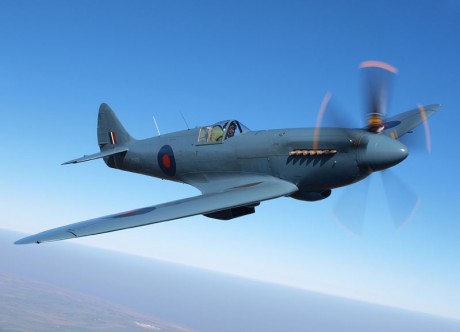
Posted on 06/02/2013 1:37:47 AM PDT by sukhoi-30mki
Spitfire vs Bf 109 and F-14 vs Su-27: the difference is always the pilot
May 31, 2013
Not always the best aircraft is the one that wins in an air-to-air engagement.
Most of the times it is the training the pilot has received and his/her skills, experience to make the difference: that’s why a well trained pilot with a less capable aircraft can defeat a more powerful plane piloted by a scarcely trained airman.
During World War II two of the most successful fighters of aviation history faced one against the other, in a duel that began over the coasts of Dunkirk and ended on the last days of the war: this two aircraft were the legendary Supermarine Spitfire and its German counterpart, the formidable Messerschmitt Bf 109.

Image credit: RAF BBMF
During the dogfights that raged in the skies several examples of both planes fell into the hands of the opponents giving both the Royal Air Force and the Luftwaffe, the opportunity to test the enemy plane.
The first intact Spitfire Mk I was captured by the Germans during the Dunkirk evacuation and immediately used by the Germans against Bf 109E in mock aerial combat.
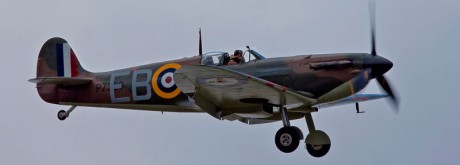
The Spitfire, that was test flown by Maj Werner Mölders in persons, which was at the time the leading ace of the Luftwaffe with 25 aerial victories, was fitted with the old two-speed propeller and had a rate of climb inferior to that of the Spitfire Mk I fitted with the constant-speed propeller.
However German pilots discovered that if the pilot pushed down the nose of the Spitfire and applied negative “G”, the carburetor float of the Merlin engine stopped to deliver fuel with the result that the engine cut out.
On the contrary, the Bf 109E did not suffer from the same problem since his Daimler Benz DB 601 was fitted with the fuel injection system. Due to this defect, Mölders thought that, even if the Spitfire had general performance approaching that of the Bf 109, it was not that good as a fighter.
A Messerschmitt was captured intact by the RAF in November 1939, when a Bf 109E was forced down in France and taken to Farnborough for test flights against the Spitfire Mk I.
The results of the test showed that Reginald Mitchell’s fighter at altitudes around 4,000 feet was far superior to the Messerschmitt Me 109E: but the captured Messerschmitt had problems with the engine cooling system and it could not prove its ability to out-climb the Spitfire at most altitudes.
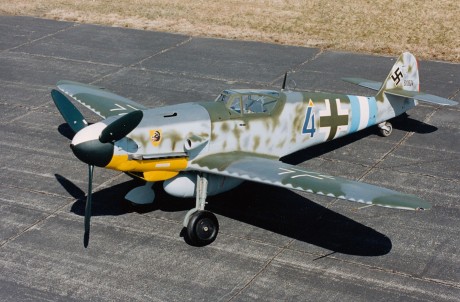
Image credit: USAF
So the British discovered that the Spitfire was better at medium altitude in a turning fight, while the Germans that the Bf 109E was better at high altitude in a high speed combat.
But those trials were valid only up to a point because when these two variants of the fighters faced one against the other was during the air battle over Britain, where the dogfights took place at altitudes between 13,000 and 20,000 feet, the altitude where the escorts for the German bombers were flown: at that height the performance of the two fighters were much closer.
However during the Battle of Britain the German fighters had a slightly advantage due to the high level of training of Luftwaffe pilots: in fact most of them, along with Mölders or Adolf Galland, were extraordinaire pilots who had gained significant experience flying with the Condor Legion during the Spanish Civil War. On the contrary the British pilots were less experienced but they flew in the skies above of their country and they fought to defend it: these two reasons, along with some strategic German mistakes, gave them a lot of motivations and brought the air duels on the same level.
During the war many other variants of these two fighters fell in the hands of each opponents, but another test was conducted early in 1944 by the RAF at Duxford. In 1944 the latest subtype of the Messerschmitt was the Bf 109G (the latest variant of the Bf 109 was the K, but it was built in small numbers and developed too late to play an important role during the war) and one of this kind of Bf 109 was tried against the new and more potent Spitfire Mk XIV powered with the Griffon 61 engine.
The result was that the Spitfire was faster than the Bf 109G at all heights, the rate of climb was the same for the two aircraft around 16,000 feet, while at the other altitudes the Spitfire Mk XIV exceeded the Bf 109G.
50 years later, in the midst of the 1990s, the technology changed the way in which the fighters fought, Air to air combat was still an important part of the training for every pilot of any air force and it is still the better way to understand how an aircraft can perform against those of their counterparts.
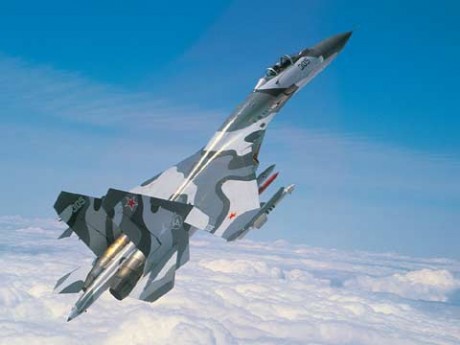
Image credit: Sukhoi
During the last decade of the twentieth century one of the deadliest adversary for the western air forces was the Sukhoi Su-27 Flanker.
The Su-27 belongs to the same class of the US F-14 and F-15, but unlike the American fighters it can fly at an angle of attack of 30 degrees and can also perform the “Pugachev Cobra”, an aerobatic maneuver in which the aircraft pitches the nose beyond the vertical at a rate of 70 degrees per second and after that recovers to level flight. Thanks to this maneuver, the Flanker has been the highlight of every air shows from the end of the 80s to the middle of the 90s.
On 20 April this year an article written by Dave Majumdar for Flightglobal DEW Line, talk about Gerry Gallop, a former TOP GUN instructor and an experienced US Navy pilot who flown F-4, F-14A and B, F-15, F-16, F-18 (both Legacy and Super Hornet) and also A-4.
Once Gallop ended its career he became senior vice president and chief operating of Tactical Air Support, a private operator which operated the Su-27 for short time and during this period he had the chance to fly the Flanker.
During one of his sorties over the Ukraine, Gallop was very impressed by the acceleration and by how fast was the Russian fighter at high altitude. The power of its engines, along with its superb aerodynamics and with short range IR missile AA-11 Archer (which in the ‘90s was the best short-range AAM in the world that can be linked to the pilot’s helmet fire control system and is capable to be fired at targets until 45 degrees off the axis of the aircraft: both these capabilities were not possessed by the AIM-9M Sidewinder, the main western short range missile at the time) made of the Su-27 probably the best dogfighter of the 90s, a very tough adversary for every western jet.
When strictly compared to the F-14, the Tomcat is not less fast than the Su -27, but for the American fighter the Flanker is more than a match in a close combat. In fact, against a more maneuverable fighter like the Su-27, the Tomcat is disadvantaged even if the F-14 is a B or a D model powered with the extremely potent General Electric F110-GE-400 engines.
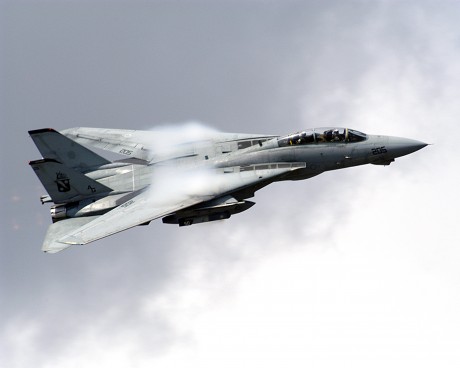
Image credit: U.S. Navy
Sometimes the advantage of an agile adversary can be reduced thanks to the presence of a well trained backseater, but the Tomcat gives the best of itself on long distances where the AIM-54C Phoenix can be used. As explained by some Tomcat drivers, it doesn’t matter how a more agile fighter can get a F-14 in a dogfight, because thanks to Tomcat’s combination of tactics, sensors (such as the F-14D’s AAS-42 which it has a greater range and resolution than the IRST seeker mounted by the Su-27) and weapons every enemy fighter is going to be destroyed at an unparalleled distance.
So, which was the best among these two fighters?
It is very hard to answer to this question, but as explained by the most experienced F-14 pilot, Dale “Snort” Snodgrass, in some ways the Su-27 is superior to the F-14 and to the F-15 while in some others, American fighters are better than the Flanker: but what really makes the difference is how well a pilot is trained.
But with the P51 vs. the Zero, inexperienced pilots were beating experienced Japanese pilots.
I wasn't aware of females having a history of success in air combat that justified the inclusion of them as a sex.
I was watching the Military Channel and one of the great historical “what ifs” that never took place. That of jet to jet fighter combat in World War II.
The British Gloster Meteor was never in a dog fight with a German ME-262. The British viewed them as too strategic an asset to lose over occupied territory and they were used exclusively to intercept V weapons.
The most important attribute of a fighter is speed. The P51D was at least 25MPH faster than the Zero at all altitudes. In WW2 air combat terms that is a phenomenal difference, implying obsolescence in the slower fighter. All you need to do in a P51 is climb above the zero and dive down on it, shooting as you go. If you get him, good. If you dont, you do not stop to dogfight (the zero is much better at that - easily more manoeverable than a P51) you just simply continue the dive and accelerate away. The zero will be lucky to even get a short innacurate burst in. Then you climb, and dive down again. Repeat, until no zeroes left. It doesnt require a very experienced pilot to do that, once you know the trick.
It was worse than that. The zeros had an engine that pushed their machine to turn right. They also had no maneuverability at high altitude, much like the FW109. There are several instances of P51’s meeting their opponents at high altitude, only to have their opponents fall into uncontrolled flight, while the P51 pilots simply picked them off.
In some ways, it wasn’t very ‘sporting’.
The most important attribute of a fighter is speed. The P51D was at least 25MPH faster than the Zero at all altitudes. In WW2 air combat terms that is a phenomenal difference, implying obsolescence in the slower fighter. All you need to do in a P51 is climb above the zero and dive down on it, shooting as you go. If you get him, good. If you dont, you do not stop to dogfight (the zero is much better at that - easily more manoeverable than a P51) you just simply continue the dive and accelerate away. The zero will be lucky to even get a short innacurate burst in. Then you climb, and dive down again. Repeat, until no zeroes left. It doesnt require a very experienced pilot to do that, once you know the trick.
Thanks for the posting
Sukhoi’s thesis is correct, it’s the pilot that makes the difference (this same principle applies to tank and armored vehicle crews). The best example of this is the two highest scoring squadrons of the Battle of Britain. Those squadrons were 301 and 303 (the Kosciusko Squadron). The Polish pilots made up 10% of the force for the RAF and were flying the older Hurricane Hawkers vice the Spitfire during this period. They scored 40% of the kills against the Luftwaffe. If you want a really good read, check out the book “A Question of Honor” by Lynn Olsen and Stanley Cloud.
Another simple comparison of aircraft would have had the Japanese Zeros making mincemeat of the Flying Tiger P-40s.
Didn’t turn out that way in real life.
Exactly. Once American pilots learned to use their fighters’ generally superior speed against Zeroes, they became easy kills. Mustangs, Corsairs, and Hellcats still couldn’t out-turn a Zero in a classic dogfight, but they didn’t need to. They dove in at speed, fired quick shots, and extended away, or used that speed to maneuver in the vertical plane to cut inside the Zero’s turn. Or Fw 190s would use their phenomenal rate of roll to quickly change direction against Spitfires and Thunderbolts and get into attack position.
It’s not just all about which fighter could simply out-turn the other in a circling dogfight. That’s just one part of the performance envelope. Look at what the Flying Tigers did with supposedly-inferior P-40s against Zeros at the height of Japanese power in 1942. They played to the Warhawk’s strength—speed, firepower, diving ability—instead of doing what most other American pilots tried at the time, which was to dogfight the Zero on its terms.
}:-)4
CC
There was still Adolph Galland’s reply to Göring during the Battle of Britain when der Dicke asked if there was anything he could do to help the Luftwaffe fighter arm. Gallandly famous replied, “Ja, get me a squadron of Spitfires!”
During the Battle of Britain the Messerschmidts were disadvantaged because of limited flying range. They only had about five minuted of fuel to fight over London, and many experienced Luftwaffe pilots were lost in the Channel. By the end of the War many raw Luftwaffe pilots entered combat with fewer hours air time than a U.S. pilot would be required to have to solo. Hitler anticipated a short war and the Luftwaffe did not establish a pipeline to train more new pilots to sustain it through the War. The Japanese had the same problem.
The U.S. Eighth Air Force specifically had the task of defeating the fighter arm of the Luftwaffe. The Luftwaffe had stopped sending up fighters to defend against bombing raids against cities or other targets except Berlin and oil fields, in order to preserve their limited strength to repel the coming invasion of Europe. The Eighth Air Force attacked Berlin, using B-17’s as live bait to force the Luftwaffe to respond. Almost 60,000 Americans were killed in the air war over Europe, but in the end, the Luftwaffe was defeated.
Thank you for the recc.
I’m sure it will sharpen my distaste for FDR...
I will get it, as well as “The Peasant Prince: Thaddeus Kosciuszko and the Age of Revolution”.
The Zero was obsolete by the time the P-51 arrived, it truly never got much better from 1941 onward. There were many Japanese fighters that were superior to the Zero.
Absolutely agree.

Also- by the time the P51 arrived ,the real expierienced
Jap pilots were dead- training was minimal- U.S.
subs had crippled the Jap economy.
And as for the battle of Britain- imagine flying
escort to London and having only 10 minutes to fight
before heading back- big mistake made by the Nazi’s.
Disclaimer: Opinions posted on Free Republic are those of the individual posters and do not necessarily represent the opinion of Free Republic or its management. All materials posted herein are protected by copyright law and the exemption for fair use of copyrighted works.